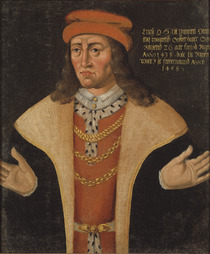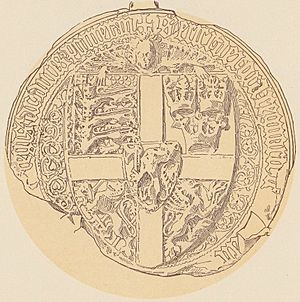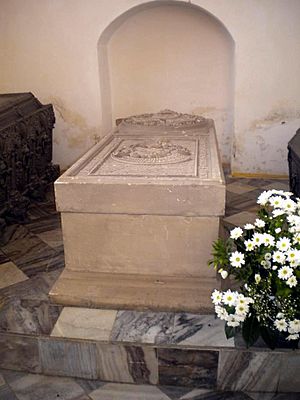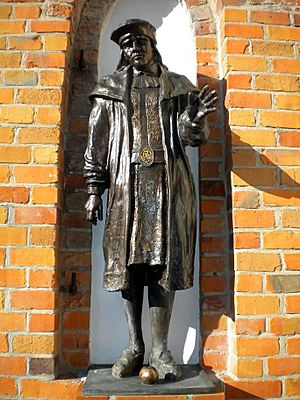Eric of Pomerania facts for kids
Quick facts for kids Eric III, VII & XIII |
|
|---|---|
 |
|
| Duke of Pomerania-Stolp | |
| Tenure | 7 December 1446 – 24 September 1459 |
| Predecessor | Bogislav IX |
| Successor | Eric II |
| Regent | Maria of Masovia (1446–49) |
| King of Denmark and Sweden | |
| Reign | 28 October 1412 – 24 September 1439 |
| Coronation | 17 June 1397, Storkyrkan (destroyed 1678), Kalmar, Sweden |
| Predecessor | Margaret I |
| Successor | Christopher III |
| King of Norway | |
| Reign | 8 September 1389 – 4 June 1442 |
| Coronation | 1392, Oslo Cathedral |
| Predecessor | Margaret |
| Successor | Christopher |
| Regent | Sigurd Jonsson |
| Born | 1381 or 1382 Rügenwalde Castle, Pomerania |
| Died | 24 September 1459 (aged 76–78) Rügenwalde Castle, Pomerania |
| Burial | St. Mary's Church, Rügenwalde |
| Spouse |
Cecilia (morganatic) |
| House | Griffin (by birth) Estridsen (by adoption) |
| Father | Wartislaw VII, Duke of Pomerania |
| Mother | Maria of Mecklenburg-Schwerin |
| Religion | Roman Catholicism |
Eric of Pomerania (born 1381 or 1382 – died 24 September 1459) was a very important ruler in Northern Europe. He led the Kalmar Union from 1396 to 1439. This union joined the kingdoms of Denmark, Norway, and Sweden.
Eric was known by different numbers in each country. He was Eric III as King of Norway, Eric VII as King of Denmark, and Eric XIII as King of Sweden. Later, people often called him Erik av Pommern (Eric of Pomerania). This name reminded everyone that he came from Pomerania, a region near the Baltic Sea. Eric eventually lost his thrones in all three kingdoms. However, he later became a duke in Pomerania until he died.
Contents
Becoming King
Eric was born as Bogusław in 1381 or 1382 in Rügenwalde, which is now Darłowo, Poland. His father was Wartislaw VII, Duke of Pomerania, and his mother was Maria of Mecklenburg-Schwerin.
Queen Margaret I ruled Denmark, Norway, and Sweden. She wanted her kingdoms to stay united and peaceful. She chose Bogusław, her sister's grandson, to be her heir.
In 1389, young Bogusław was brought to Denmark. Queen Margaret raised him and changed his name to the more Nordic-sounding Erik. On September 8, 1389, he was recognized as King of Norway.
After his father died, Eric inherited his family's titles. In 1396, he was declared king in Denmark and then in Sweden. On June 17, 1397, he was crowned king of all three Nordic countries in Kalmar, Sweden. This event officially created the Kalmar Union. Even though Eric was crowned, Queen Margaret remained the main ruler until she died in 1412.
His Royal Marriage
In 1402, Queen Margaret started talks with King Henry IV of England. They discussed a possible alliance between England and the Nordic union. They even thought about a double wedding. King Eric would marry Henry's daughter, Philippa of England. Also, Henry's son, who would become King Henry V, would marry Eric's sister, Catherine.
The double wedding didn't happen. But Eric's marriage to Philippa of England was agreed upon. On October 26, 1406, he married 12-year-old Philippa in Lund. This marriage also created a defensive alliance with England. After Philippa died in 1430, Eric found a new partner. She was Cecilia, who had been Philippa's lady-in-waiting.
Ruling the Kingdoms
Early in his rule, King Eric made Copenhagen a royal city in 1417. This helped make it the capital of Denmark. He also took control of Copenhagen Castle from the local bishop.
People at the time described King Eric as smart and full of energy. He was also charming and good at speaking. He went on a big trip around Europe in the 1420s. However, he could also be quick-tempered and stubborn. A future pope described Eric as having "a beautiful body, reddish yellow hair, a ruddy face, and a long narrow neck." He added that "all women were drawn to him."
From 1423 to 1425, King Eric went on a special trip to Jerusalem. While he was away, Queen Philippa managed the three kingdoms from Copenhagen.
King Eric spent most of his rule fighting with the rulers of Holstein. He wanted to get back South Jutland (Schleswig). This led to a long, difficult war. The war did not help him gain new land. It also cost a lot of money and weakened the unity of the northern kingdoms. In 1424, a ruling by the Holy Roman Emperor said Eric was the rightful ruler of South Jutland. But the Holsteiners ignored it.
The Sound Dues
Perhaps Eric's most important action was starting the Sound Dues in 1429. This was a tax on all ships passing through the Sound between Denmark and Sweden. This tax lasted until 1857. To make sure ships paid, King Eric built a strong fortress called Krogen (later Kronborg) at the narrowest part of the Sound.
This tax gave his kingdom a lot of steady income. It made the town of Elsinore rich and busy. It also showed Eric's interest in Danish trade and sea power. However, it also caused problems with other powerful groups in the Baltic Sea, especially the Hanseatic League. He fought a war with them and Holstein from 1426 to 1435. In 1428, the Hanseatic League and Holstein attacked Copenhagen. King Eric left the city, but Queen Philippa bravely led the city's defense.
Challenges and Rebellions
In the 1430s, King Eric's plans started to fall apart. In 1434, farmers and miners in Sweden began a rebellion. Swedish nobles then used this uprising to weaken the King's power. This was called the Engelbrekt rebellion. It hurt the unity of the Kalmar Union and led to Danish forces being temporarily kicked out of Sweden. In Norway, another rebellion happened in 1436.
King Eric had to give in to the demands of Holstein and the Hanseatic League. In April 1435, he signed a peace treaty. Under this treaty, Hanseatic cities did not have to pay the Sound Dues. Also, the Duchy of Schleswig was given to the count of Holstein.
Losing His Thrones
The Danish nobles did not like Eric's rule. They refused to agree to his choice for the next King of Denmark. In response, King Eric left Denmark. He moved to Visborg Castle in Gotland permanently.
Because he left, the national councils of Denmark and Sweden removed him from power in 1439. In 1440, Eric's nephew, Christopher of Bavaria, was chosen as the new King of Denmark and Sweden. At first, the Norwegian council stayed loyal to Eric. But with Eric isolated in Gotland, the Norwegian nobles also decided to remove him. He was officially removed in 1442, and Christopher became King of Norway too.
After King Christopher died in 1448, Eric's relative, Christian of Oldenburg, became King of Denmark. Karl Knutsson Bonde became King of Sweden. These two kings then competed for the throne of Norway. In 1450, Karl had to give up the Norwegian throne to King Christian.
Duke of Pomerania
For ten years, Eric lived in Gotland. During this time, he often fought against the merchant ships in the Baltic Sea.
From 1449 to 1459, Eric became the Duke of Pomerania. He ruled a small part of the Duchy of Pomerania called Pomerania-Rügenwalde. He was known as "Eric I" there. He died in 1459 at Darłowo Castle and was buried in St. Mary's Church in Darłowo.
Royal Titles
Eric's full title was: "King of Denmark, Sweden and Norway, the Wends and the Goths, Duke of Pomerania".
Family Connections
| Valdemar IV of Denmark | |||||||||||||||||||||||||||||||
| Bogislaw V of Pomerania | Ingeborg of Denmark | Margaret I of Denmark | |||||||||||||||||||||||||||||
| Bogislaw VIII of Pomerania | Wartislaw VII of Pomerania | Maria of Mecklenburg-Schwerin | |||||||||||||||||||||||||||||
| Bogislaw IX of Pomerania | Catherine of Pomerania | Eric of Pomerania | |||||||||||||||||||||||||||||
| Christopher of Bavaria (King of Denmark) | |||||||||||||||||||||||||||||||
Images for kids
-
King Eric (right) met with Emperors John VIII Palaiologos and Sigismund in Buda in 1424.
See also
 In Spanish: Erico de Pomerania para niños
In Spanish: Erico de Pomerania para niños







